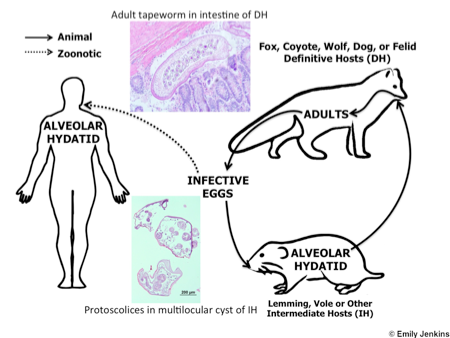Echinococcus multilocularis
Contributor: Emily Jenkins, Lydden Polley, Janna Schurer and Karen Gesy
Biology: Cestode (tapeworm) in the Family Taeniidae. Adult cestodes (1-5 mm in size) live in the small intestine of carnivore definitive hosts (fox, coyote, wolf, dogs, and, rarely, cats) Identified as being distinct from E. granulosus in the 1950’s, and as an established zoonoses in many countries in the northern hemisphere. In Canada, it is established in the southern half of the prairie provinces (Manitoba, Saskatchewan, and Alberta), and in the Northwest Territories and Nunavut. The strains present in the prairie region are similar to those present in the northcentral USA, while the strains present in northern Canada may be more closely linked to Asian strains present in Alaska. Recently, a European-type strain has been identified in central British Columbia that may be a more recent introduction.

Figure 1. Adults of Echinococcus multilocularis.
Life Cycle: Adult cestodes (1-5 mm in size) live in the small intestine of carnivore definitive hosts (fox, coyote, dogs, and, rarely, cats). Eggs (32-37 µm in diameter) are shed in faeces and are indistinguishable from those of other taeniid cestodes (Taenia species). Eggs are immediately infectious and environmentally resistant. Rodent (voles, deer mice, muskrats, etc.) intermediate hosts ingest the eggs on vegetation, on the soil surface, or in surface water. In the intermediate host, larval tapeworms (protoscolices) develop in multi-chambered cysts (alveolar hydatids) in the liver. The cysts may take over the whole abdominal cavity. The life cycle is completed when a carnivore ingests a cyst in a rodent.

Figure 2: Life cycle of Echinococcus multilocularis in northern North America. The larval (or metacestode) stage takes the form of a multilocular hydatid cyst (alveolar hydatid).
Transmission: Humans are infected through accidental consumption of eggs shed in faeces of dogs, wild carnivores, or, less likely, cats, that hunt or scavenge rodents. As eggs are sticky, immediately infective, and environmentally resistant, it is possible that eggs can stick to perianal fur of infected dogs, cats, or wild carnivores. People do NOT become infected through consumption of cysts in rodents. In most cases, dogs acquire adult stages of E. multilocularis from consuming infected rodents. In rare cases, dogs can acquire the larval stage by eating eggs in faeces of another dog or carnivore. Three cases of canine alveolar hydatid disease have been detected in Canada to date, with poor clinical outcomes.
Prevalence: Only two human cases are thought to have been acquired in Canada and the lower 48 US states – one case in Manitoba in the 1930’s and one case in Minnesota in the 1970’s. Western Alaska (including islands in the Bering Sea) is an endemic region, with 54 human cases reported between 1946-1986. Alveolar hydatid disease is not a nationally notifiable disease in people in Canada. It is possible that human cases of alveolar hydatid cyst are misclassified as cystic hydatid disease or hepatic carcinoma.
Susceptible Populations: Indigenous and northern populations, trappers and berry harvesters. There is currently no evidence to suggest an increased incidence in these populations in Canada.
Symptoms: Symptoms may take many years to develop. In people, the cyst membrane behaves abnormally, spreading throughout the liver and abdominal cavity. Symptoms therefore reflect compromised liver function and mimic invasive tumors.
Treatment: Successful treatment relies on aggressive early intervention including surgical removal and long-term therapy with parasiticides such as albendazole. Even with treatment, prognosis is not good.
Control Measures: Good practices include dog population control and civic regulations for free-roaming dogs and pooper-scooping, good hand hygiene following handling of dogs, trapped or hunted foxes and coyotes, and faeces. Dogs and cats with access to rodents in endemic regions should be dewormed using praziquantel or an effective cestocide on a monthly basis, to eliminate infections before eggs are shed in faeces. Eggs are resistant to most chemical disinfectants, but are killed by temperatures colder than -80°C for 3-5 days, and have decreased survival in hot, dry conditions. At the consumer/food handler level, thorough washing of fruits and vegetables harvested in endemic regions and effective filtering of untreated surface water prior to consumption is recommended.